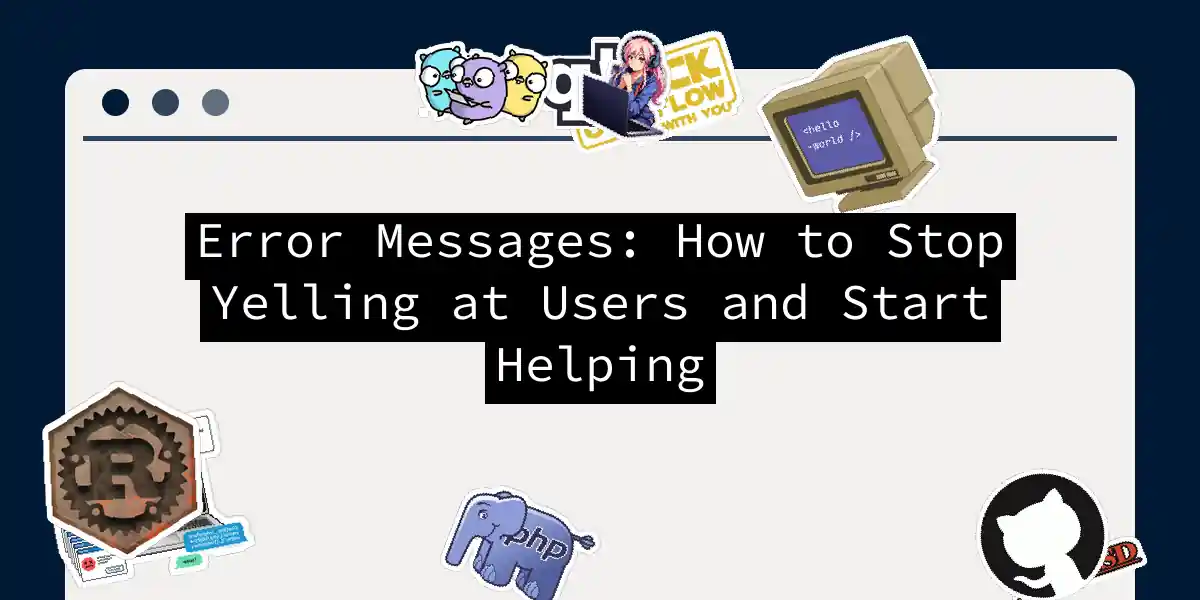Picture this: you’re trying to book a concert ticket at 2 AM, caffeine-deprived and determined. The website throws an error - “SYSTEM_ERR_CODE 0xDEADBEEF: Invalid flux capacitor alignment”. Suddenly you’re not just battling sleep deprivation but also existential dread. This, friends, is why error handling matters more than your favorite framework’s latest syntactic sugar. Let’s turn those digital rage-inducers into something that actually helps users (and saves your support inbox). Here’s my battle-tested recipe for error messages that don’t suck.
1. Build Your Error Taxonomy Like a Pokemon Master
Just as Pikachu evolves into Raichu, your errors need proper lineage. Let’s create an error hierarchy that would make Darwin proud:
class ApplicationError extends Error {
constructor(message) {
super(message);
this.name = this.constructor.name;
this.isOperational = true;
Error.captureStackTrace(this, this.constructor);
}
}
// Validation errors - the "you done goofed" family
class ValidationError extends ApplicationError {}
class RequiredFieldError extends ValidationError {
constructor(field) {
super(`Hold up! We need your ${field} to continue`);
this.field = field;
}
}
// API errors - when the internet gremlins strike
class APIError extends ApplicationError {
constructor(endpoint) {
super(`Our hamsters powering ${endpoint} need a coffee break`);
this.retryAfter = 30000;
}
}
Now you can catch specific errors like a pro:
try {
await submitForm();
} catch (error) {
if (error instanceof RequiredFieldError) {
highlightMissingField(error.field);
} else if (error instanceof APIError) {
showRetryButton(error.retryAfter);
} else {
// Our final form: unexpected errors
logToSentry(error);
showPanicMessage();
}
}
Your error taxonomy should grow like a well-organized toolbox - not like that junk drawer full of random USB cables. Group errors by domain (validation, API, auth) and inherit responsibly.
2. Write Messages Like a Human, Not HAL 9000
Bad error messages are like bad first dates - confusing, frustrating, and leaving you wondering what went wrong. Let’s fix that with the WAIT principle:
- What happened?
- Action required
- Instructions (optional)
- Tech details (hidden) The Good, the Bad, and the “WTF”:
// Bad: "Invalid input"
// Worse: "ERR_CODE 418: Tea pot overflow"
// Best: "Whoops! Email address needs that @ symbol. Like [email protected]"
class InvalidEmailError extends ValidationError {
constructor(value) {
super(`Email address needs that @ symbol. We received: ${value}`);
this.example = "[email protected]";
}
}
// Bonus: Add troubleshooting in the error object
error.helpDocs = "https://example.com/email-format-guide";
Pro tip: Store user-friendly messages separately from error codes. Think of it like IKEA instructions - simple pictures for users, part numbers for support.
3. The Error Handling Circus: Try/Catch/Finaly Edition
Error handling is like a three-ring circus. Let’s break down the main acts:
Real-world example with resource cleanup:
async function processOrder(userId) {
let dbConnection;
try {
dbConnection = await connectToDatabase();
const cart = await dbConnection.getCart(userId);
if (!cart.items.length) {
throw new ValidationError("Your cart is emptier than a college fridge");
}
const paymentResult = await processPayment(cart);
return await createOrder(dbConnection, paymentResult);
} catch (error) {
if (error instanceof ValidationError) {
await sendUserNotification(userId, error.message);
} else {
await logErrorToService(error);
await triggerIncidentWorkflow(error);
}
throw error; // Let upstream handlers decide
} finally {
if (dbConnection) {
await dbConnection.cleanup();
}
}
}
Notice how we:
- Initialize resources outside try block
- Handle expected errors (validation)
- Cleanup in finally - crucial for preventing memory leaks
- Re-throw for global handler
4. The Error Autopsy: Logging Like a CSI Team
When errors happen, you need more clues than a Agatha Christie novel. Implement the 5 Ws of Error Logging:
class ErrorLogger {
static log(error) {
const entry = {
when: new Date().toISOString(),
what: error.message,
where: error.stack?.split('\n')?.trim(),
who: getCurrentUser()?.id || 'anonymous',
why: error.constructor.name,
how: {
code: error.code,
extra: error.context
}
};
sendToLogService(entry);
if (!error.isOperational) {
triggerPagerDuty(entry);
}
}
}
// Usage
try {
riskyOperation();
} catch (error) {
ErrorLogger.log(error);
throw error;
}
Your logs should tell a story clearer than a Netflix true crime documentary. Include:
- User context (without PII)
- Stack trace
- Error code
- Environment details
- Breadcrumbs (previous actions)
5. The User’s Survival Kit: Frontend Edition
In React-land, error boundaries are your emergency flares. Let’s create one that’s more helpful than a GPS with dead batteries:
class ErrorBoundary extends React.Component {
state = { hasError: false };
static getDerivedStateFromError() {
return { hasError: true };
}
componentDidCatch(error, info) {
logErrorToService(error, info.componentStack);
}
render() {
if (this.state.hasError) {
return (
<div className="error-boundary">
<h2>⚠️ Well butter my biscuit!</h2>
<p>This component went rogue. We've sent the coding ninjas to fix it.</p>
<button onClick={this.handleRetry}>Retry</button>
<details>
<summary>Technical details for nerds</summary>
<code>{this.state.error?.toString()}</code>
</details>
</div>
);
}
return this.props.children;
}
}
Key features:
- Friendly message (no technical jargon)
- Recovery option
- Hidden tech details
- Automatic error reporting
6. The Art of Error-Driven Development
Turn errors into features with this dev cycle:
- Track common errors in production
- Analyze patterns (bad inputs? API flakiness?)
- Prevent through:
- Better validation
- Retry logic
- User education
- Monitor improvements Example: If you see frequent “Invalid Date” errors:
// Before
<input type="text" name="birthdate">
// After
<DatePicker
minDate={new Date(1900, 0, 1)}
maxDate={new Date()}
locale="user-locale"
format="MM/DD/YYYY"
/>
Bonus: Add inline validation as users type!
The Grand Finale: Your Error Handling Checklist
Before you deploy, ask:
✅ Did we replace all “Something went wrong” with helpful messages?
✅ Can users recover without calling their tech-savvy nephew?
✅ Are errors logged with enough context to reproduce?
✅ Have we tested both sunny-day and thunderstorm scenarios?
✅ Would my grandma understand the error messages? (RIP, Nana)
Remember: Good error handling is like a good wingman - it doesn’t prevent all mistakes, but makes recovery smooth and painless. Now go forth and turn those error screens from rage-inducing red to calming green! 🚦
